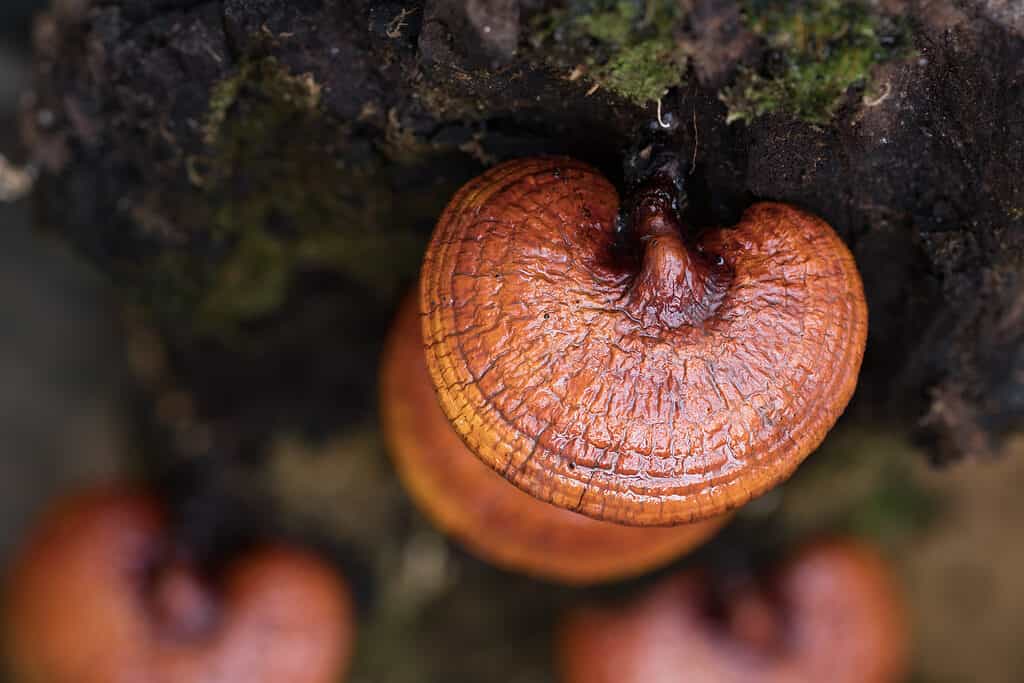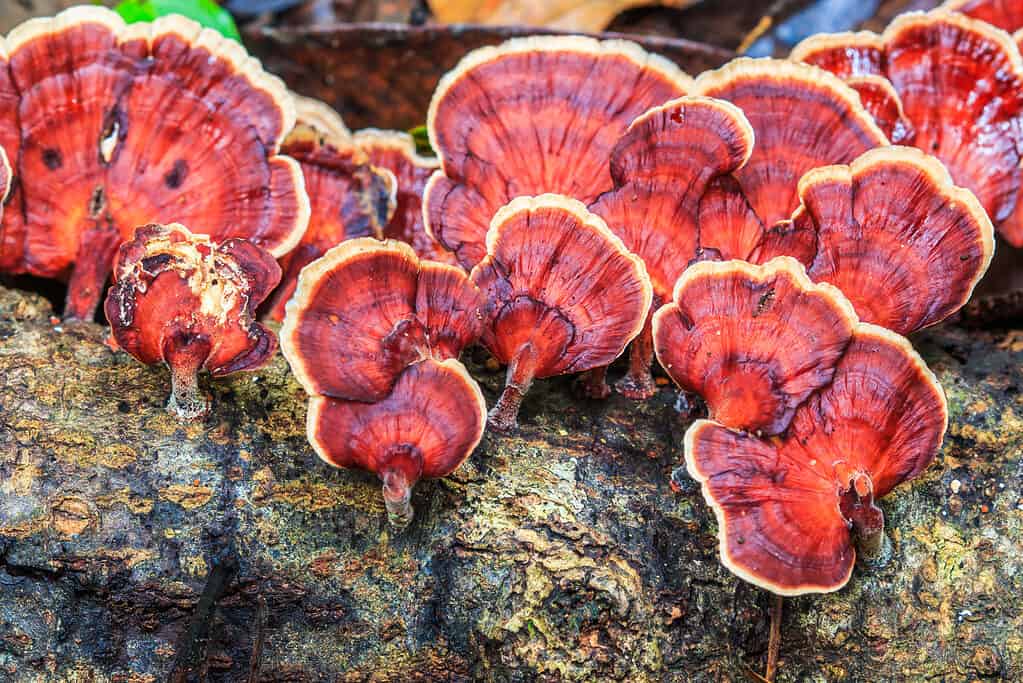Whether small or large, there are literally 14,000+ mushrooms species in the world. Many of them are flavorful and rich, favored highly by chefs for their distinctive flavor and rare availability, while others are more on the bland side and preferred for their nutritional properties.
Reishi mushrooms are just such fungi – preferred for what they offer rather than how they taste. Many cultures claim them to have significant health benefits, even dubbing these shrooms the mushroom of immortality. They’ve been used in ancient Chinese medicine for millennia, helping to lend to that legend and common name of “mushroom of immortality.”
Let’s dig in and see what’s up with them and how – or if – you should see about including them in your diet.
Reishi Mushroom Classification

©Piyawit chiang-ngern/Shutterstock.com
Reishi mushrooms, or Ganoderma lingzhi, are part of the genus Ganoderma. They are a polypore fungus or bracket fungus, native to East Asia. The mushroom has many common names, with the most well-known among them being Champignon Reishi, Ganoderma, Ling Chih, Ling Zhi, Lingzhi, Mannentake, mushroom of immortality, mushroom of spiritual potency, red reishi, reishi antler mushroom, reishi rouge, rei-shi, and spirit plant.
The name Lingzhi comes from its Japanese pronunciation, which translates as “mushroom of immortality,” fitting its 2000+ year old reputation as a healer. The mushrooms sold under this name in various medicinal shops, groceries, and others may be any among 8 species, but most commonly those going by the name of reishi refer to this singular fungus.
Where Do Reishi Mushrooms Grow?

©cholprapha/Shutterstock.com
The fungus is native to East Asia, but may be found elsewhere, thanks to its exportation over the centuries. It’s in North America, Europe, and possibly in the Mediterranean region. It will primarily be found at the bases of trees and stumps of deciduous trees such as maples. The mushroom is rare in the wild, however, and mostly is cultivated for herbal remedy and traditional medicinal purposes among hardwood logs, wood chips, and sawdust.
The mushrooms are technically a white rot fungus and may be parasitic, growing on live trees. More often, however, they’re growing on stumps and dead logs.
Are Reishi Mushrooms Safe to Eat?
Reishi mushrooms are safe for consumption, though they are typically chosen not for culinary flavor but rather for medicinal properties. The yellow internal portion of the mushroom is bitter so most folks avoid eating it, with the focus on the white flesh as the edible portion of the fungus.
What Do Reishi Mushrooms Taste Like?

©tarapong srichaiyos/Shutterstock.com
Typically favored for possible health benefits rather than flavor, the reishi mushroom is considered by many as the least appealing mushroom when it comes to flavor. They’re described as having “earthy bitterness” to their flavor, though may be more flavorful and less bitter when prepared properly.
The inner yellow part of the mushroom is what has the bitter a taste and the white portion of the mushroom is described as mildly meaty or more on the bland side.
Health Benefits of Reishi Mushrooms

©frank60/Shutterstock.com
Reishi mushrooms, like most fungi, contain multiple nutrients that are linked to healthy living. There is no specific scientific backing supporting reishi mushrooms as the “mushroom of immortality,” of course, but the nutrients contained therein have been shown to offer the health benefits touted by mushrooms lovers.
Reishi mushrooms contain antioxidants which are believed to help reduce blood sugar (show in animals), reduce bacteria, and generally boosting the immune system. They have been used in some treatments for cancer, diabetes, cold sores, Alzheimer’s and other conditions and diseases. Some believe the mushrooms to help lower cholesterol, however there isn’t any specific evidence to support this.
It is recommended that those who are pregnant or breast-feeding should avoid reishi mushrooms, those who have bleeding disorders, and those who have recently had surgery should also avoid.
How Are Reishi Mushrooms Used?

©JIB Liverpool/Shutterstock.com
Reishi mushrooms, as noted, may not be the most favored for their flavor, as other mushrooms have more distinctive taste, but the fungus is used frequently in multiple recipes, served as an herb rather than being used as a spice, meaning it should not be used in large doses. Some people have some stomach upset after consuming too much of the mushroom repeatedly.
Avoid using the yellow portion from the interior of the mushroom. Instead, focus on the white portion. The yellow section is the most bitter portion is most likely to cause stomach upset and avoid using too much of it in a single meal or dish.
Reishi mushrooms are most often used in soups and teas, however the tea most often is made with alcohol rather than water, for anti-inflammatory effects.
How Much Do Reishi Mushrooms Cost?
Because of the favor of reishi mushrooms in medicinal uses and the rarity of the mushroom, reishi mushrooms tend to be on the more expensive side. They are often priced at around $7.00 per ounce or higher and are sold in limited quantities to prevent exclusions.
How to Identify Reishi Mushrooms
These mushrooms have hard, flat, zoned bracket, reddish brown, shiny caps. They grow at the base of living and dead deciduous trees and stumps from May to November. The mushrooms are shelflike and grow on the bark in semicircular shapes. They’re lighter in color toward the margins and rarely have a present stalk/stem. The caps may be anywhere from 1 to 14 inches wide and look shiny, almost like they’re lacquered.
Where to Forage for Reishi Mushrooms?

©apiguide/Shutterstock.com
While these mushrooms are fairly rare to find in the wild, they’re not impossible to locate, depending on where you head into the forest. If you’re foraging in the USA, you’ll find different species based on the geographic region based on the type of trees in the area. There are 13 distinct species in the USA, with them favoring hemlocks in the northeast. You’ll find them in
- California
- Colorado
- Texas
- Oklahoma
- Louisiana
- Illinois
- Florida
- North Carolina
- South Carolina
- Oregon
- Washington
- Georgia
- Alabama
- Missouri
- Tennessee
- Minnesota
- Pennsylvania
- New York
- Possibly others
Reishi Mushroom Trivia

©StaryTale/Shutterstock.com
These mushrooms were once saved exclusively for Asian royalty, based on their rarity and presumed medicinal properties. The mushrooms are still rare and hard to find compared to many edible species, but most commonly will be found in mushroom tea blends.
The mushrooms are referenced throughout ancient poetry in the 1st Century BC, by Emperor Wu of Han and Ban Gu. There’s an actual ode to the mushroom found among ancient hieroglyphs.
The Taoist temples were called the abode of mushrooms, and according to those ancient teachings, the use of these mushrooms, they were concentrated to create hallucinogenic offerings for use in spiritual practices. This is part of why the mushrooms are known as immortals, spirits, and heavenly mushrooms in one form or another.
Philosopher Huainanzi spoke of reishi mushrooms as the personification of nobility and the Divine Farmer’s Classic of Pharmacettics from 200-250 CE classifies the mushrooms into six different color categories, each providing life force to the different parts of the body, specifically the liver, the heart, the spleen, the kidneys, the lungs, and the essence (possibly spirit or soul). The mushroom was noted as being used for immortality, specifically, in the Taoist treatise of Boapuzi from Ge Hong.
The mushroom appears frequently in Chinese art symbolizing great health and longevity, specifically in the imperial Summer Palace and Forbidden City. The mushroom is often worn in a talisman for luck, as well, with hope for healing.
Editor’s Note: While A-Z Animals does its best to ensure the accuracy of its content and photography, do not eat wild mushrooms without firsthand knowledge from a local mycologist or mushroom expert as many types of mushrooms look similar.
Up Next:
- Parasol Mushrooms: A Complete Guide
- Puffball Mushrooms: A Complete Guide
- Hen of the Woods Mushrooms: A Complete Guide
- Black Trumpet Mushrooms: A Complete Guide
The post Reishi Mushrooms: A Complete Guide appeared first on AZ Animals.
from Animal News, Facts, Rankings, and More! - AZ Animals https://ift.tt/WnYwvzy